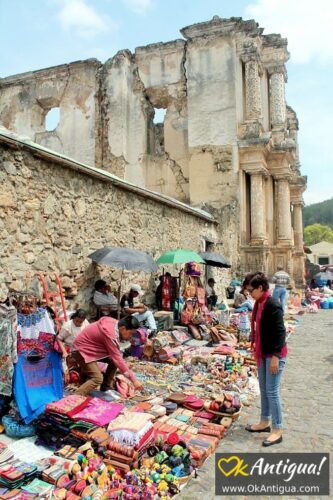 |
| Modest Iximché inspires the enchanted, historic and sacred with all new depth of meaning |
During Christmas and up until yesterday, Juan Carlos and I had the pleasure of hosting guests who visited us from San Juan, Puerto Rico and San Francisco, California.
 |
| Popol Vuh with Catholic ¨elements¨ too |
One of our most favorite local places to revisit, explore and admire is the Maya Ruins of Iximché which are not too far from our home in the rural Guatemalan countryside. Everytime I visit Iximché I notice that as we enter these sacred Maya grounds a secure feeling of tranquility and peace sweeps over me--a feeling of well-being and holiness that is unique to this place as I´ve never noticed those same feelings anywhere in the World including great Churches, Temples and other Holy places.
The day before yesterday, Juan Carlos, my friends and I were privileged to enjoy Iximché and experience the great sense of ongoing human and divine spirit presence, both ancient and contemporary, as the site reveals itself to most all who enter.
 |
| Iximché embraces our visitors. |
 |
| Iximché is ¨soothing¨ to the Spirit |
¨Iximche (or Iximché using Spanish orthography) is a Pre-Columbian Mesoamerican archaeological site in the western highlands of Guatemala. Iximche was the capital of the Late Postclassic Kaqchikel Maya kingdom from 1470 until its abandonment in 1524. The architecture of the site included a number of pyramid-temples, palaces and two Mesoamerican ballcourts. Excavators uncovered the poorly preserved remains of painted murals on some of the buildings and ample evidence of human sacrifice...


For many years the Kaqchikel served as loyal allies of the K'iche' Maya. The growing power of the Kaqchikel within the alliance eventually caused such friction that the Kaqchikel were forced to flee the K'iche' capital and found the city of Iximche. The Kaqchikel established their new capital upon an easily defensible ridge almost surrounded by deep ravines. Iximche developed quickly as a city and within 50 years of its foundation it had reached its maximum extent. The rulers of Iximche were four principal lords drawn from the four main clans of the Kaqchikel, although it was the lords of the Sotz'il and Xahil clans who held the real power.
 |
| The Ritual Fires of Divine Tribute and Cleansing smoulder on as volcanos smoke on the horizon |
After the initial establishment of Iximche, the K'iche' left the Kaqchikel in peace for a number of years. The peace did not last and the Kaqchikel soundly defeated their former overlords around 1491. This was followed by infighting among the Kaqchikel clans with the rebel clans finally being overcome in 1493. Wars against the K'iche' continued throughout the early 15th century. When the Spanish conquistadors arrived in Mexico, the Aztec emperor sent messengers to warn the Kaqchikel. After the surrender of the Aztecs to Hernán Cortés, Iximche sent its own messengers to offer a Kaqchikel alliance with the Spanish. Smallpox decimated the population of Iximche before the physical arrival of the Europeans.
 |
| Pedro de Alvarado arrived at Iximché in 1524 |
At the time of the Spanish Conquest Iximche was the second most important city in the Guatemalan Highlands, after the K'iche' capital at Q'umarkaj. Conquistador Pedro de Alvarado was initially well received in the city in 1524 and the Kaqchikel kings provided the Spanish with native allies to assist in the conquest of the other highland Maya kingdoms. Iximche was declared the first capital of the Kingdom of Guatemala in the same year. Due to excessive Spanish demands for tribute the Kaqchikel soon broke the alliance and deserted their capital, which was burned 2 years later by Spanish deserters. The Europeans founded a new town nearby but abandoned it in 1527 due to the continued hostility of the Kaqchikel, who finally surrendered in 1530.
 |
| During the Guatemalan Civil War in the 1980´s a meeting took place at the ruins between guerillas and Maya leaders that resulted in the guerillas stating that they would defend indigenous rights |
The ruins of Iximche were first described by a Guatemalan historian in the late 17th century. They were visited various times by scholars during the 19th century, who published plans and descriptions. Serious investigations of the site started in the 1940s and continued sporadically until the early 1970s. In 1980, during the Guatemalan Civil War, a meeting took place at the ruins between guerillas and Maya leaders that resulted in the guerillas stating that they would defend indigenous rights. A ritual was carried out at the site in 1989 in order to reestablish the ruins as a sacred place for Maya ceremonies. United States President George W. Bush visited the site in 2007, and in the same year Iximche was the venue for the III Continental Summit of Indigenous Peoples and Nationalities of Abya Yala.
 |
| Iximche was called ¨Guatemala¨ by the Spanish, from the Nahuatl Quauhtemallan meaning "forested land" |
EtymologyThe site's name dervives from the Mayan name of the breadnut tree (Brosimum alicastrum), from the words ixim and che, meaning literally "maize tree". Iximche was called Guatemala by the Spanish, from the Nahuatl Quauhtemallan meaning "forested land". Since the Spanish conquistadors founded their first capital at Iximche, they took the name of the city used by their Nahuatl-speaking Mexican allies and applied it to the new Spanish city and, by extension, to the kingdom. From this comes the modern name of the country. The site has also been referred to as Patinamit by 19th century investigators, a Kaqchikel word meaning "the city".
read it all,
HERE
 |
| The Textures of Living upon once Living Textures everywhere (both seen and unseen/now and before now) |
· Thanks to Wikipedia
· Thanks to Juan Carlos, Photos







































_-_James_Tissot_-_overall.jpg)













No comments:
Post a Comment